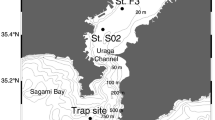Abstract.
A sediment trap deployment was made at a station (64°42′S, 139°59′E) at five depths (537, 796, 1,259, 1,722, 2,727 m) in the marginal ice zone (MIZ) of the Antarctic Ocean during a summer productive period from 26 December 1994 to 20 January 1995. This aim of the study was to reveal a possible occurrence of a sporadic bloom in surface layers and to evaluate the role of fast-sinking particles in transportation processes of bloom-derived material down to mesopelagic and bathypelagic layers. During the observation, a marked flux increase (70.5 mg C m–2 day–1, 7.7 mg N m–2 day–1) was observed at the depth of 537 m on 7–9 January. The increased flux at 537 m decreased with depth and time. The same mass of sinking particles forming the flux maximum at each depth sank down from the shallowest trap (537 m) to the deepest trap (2,727 m) within 4–11 days, indicating that these particles were transported downward to the bottom with the sinking rate of >200 m day–1. Collected particles were composed of two major particle fractions; one was dominated by fecal pellets of macrozooplankton (mainly Euphausia superba) with relatively fast sinking rates (FSP; fast-sinking particles) and the other by minute diatoms of Fragilariopsis curta with slow sinking rates (SSP; slowly sinking particles). According to the comparison of time depth changes of these two fractions, the SSP had unexpectedly faster sinking rates comparable with the FSP during the periods of maximum fluxes, probably indicating the SSP were transformed from the FSP during sinking. The present result strongly suggests that a local bloom of F. curta and intensified zooplankton grazing activities occurred in surface layers in a few days in the MIZ, and then the egested fecal pellets were rapidly transported downward with fragmentation processes into small-sized minute particles in mesopelagic and bathypelagic layers.
Similar content being viewed by others
Author information
Authors and Affiliations
Additional information
Electronic Publication
Rights and permissions
About this article
Cite this article
Suzuki, H., Sasaki, H. & Fukuchi, M. Short-term variability in the flux of rapidly sinking particles in the Antarctic marginal ice zone. Polar Biol 24, 697–705 (2001). https://doi.org/10.1007/s003000100271
Accepted:
Issue Date:
DOI: https://doi.org/10.1007/s003000100271




